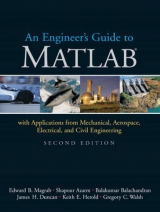
An Engineer's Guide to MATLAB
Pearson (Verlag)
978-0-13-011335-1 (ISBN)
- Titel erscheint in neuer Auflage
- Artikel merken
For engineering students in MATLAB and Numerical Methods courses.
The text is designed to develop a strong working knowledge of MATLAB, and to use this capability to write efficient, compact programs to solve engineering problems of varying complexity. It can also be used as a supplement for many engineering courses that use MATLAB, as a reference for obtaining numerical solutions to a wide range of engineering problems and as a source of applications of a wide variety of MATLAB solution techniques.
EDWARD B. MAGRAB is a Professor in the Department of Mechanical Engineering, University of Maryland, College Park. He has been an active researcher in vibrations, acoustics and, more recently, in the integration of design and manufacturing. Prior to joining the University of Maryland he held several supervisory positions at the National Institute of Standards and Technology (NIST), including Chief of the Sound Section, Head of the Robot Metrology Group and Manger of the vertical machining work station in their Automated Manufacturing Research Facility. He went to NISTafter being a Professor in the Department of Mechanics at the Catholic University of America, Washington, DC. He has written numerous journal articles and authored five other books on vibrations, noise control, dynamic measurements and integrated design. Dr. Magrab is a fellow of ASME and a registered Professional Engineer in the state of Maryland.
1. Introduction.
Introduction. Ways to Use MATLAB. Creating Variable Names. Management of Variable. Accessing Scripts and Function Files. Command Window Management. Script and Function Output to the Command Window. Basic MATLAB Syntax. Some Suggestions of How to Use MATLAB.
2. Matrices and MATLAB.
Introduction. Matrices and Vectors. Creation of Vectors. Creation of Matrices. Dot Operations. Mathematical Operation with Matrices.
3. Data Input/Output.
Strings (Literals) and Annotated Output. Entering Data with input. Input/Output Data Files.
4. Program Flow Control.
Introduction. Control of Program Flow. Two Applications of Program Control Structures.
5. Functions.
Introduction. The Function File. inline. Creating Functions That Use feval (Function of Functions). MATLAB Functions That Use feval. Examples of Several Other MATLAB Functions.
6. 2D Graphics.
Introduction. Basic 2D Plotting Commands. Graph Annotation and Visual Enhancement.
7. 3D Graphics.
Lines in 3D. Surfaces.
8. Design of Machine Elements.
Vectors, Forces, and the Equilibrium of Rigid Bodies. Stresses and Deflections in Beams, Columns, and Shafts. Stresses in Spur Gears. Kinematics of a Four-Bar Linkage. Cam Profiles and Synthesis. Hydrodynamic Bearings. PDE Toolbox and the Stress Concentration Factor for Notches in a Thin Plate.
9. Dynamics and Vibrations.
Orbital Motions. Single-Degree-of-Freedom Systems. Multi-Degree-of-Freedom Systems. Vibrations of Thin Beams.
10. Control Systems.
Introduction to Control System Design. Representations of Systems in MATLAB. Response of Systems. Design Tools. Design Examples.
11. Fluid Mechanics.
Hydrostatics. Internal Viscous Flow. External Flow.
12. Heat Transfer.
Heat Conduction. Sizing of Shell and Tube Heat Exchangers. Convection of Heat Transfer. Radiation Heat Transfer.
13. Optimization.
Definition, Formulation, and Graphical Solutions. Linear Programming. Nonlinear Programming. Single-Objective Constrained Methods. Multiobjective Optimization.
14. Engineering Statistics.
Descriptive Statistical Quantities. Probability Distributions. Confidence Intervals. Hypothesis Testing. Linear Regression. Design of Experiments.
Index.
| Erscheint lt. Verlag | 4.9.2000 |
|---|---|
| Sprache | englisch |
| Maße | 177 x 235 mm |
| Gewicht | 1056 g |
| Themenwelt | Informatik ► Office Programme ► Outlook |
| Mathematik / Informatik ► Informatik ► Theorie / Studium | |
| Technik ► Maschinenbau | |
| ISBN-10 | 0-13-011335-2 / 0130113352 |
| ISBN-13 | 978-0-13-011335-1 / 9780130113351 |
| Zustand | Neuware |
| Informationen gemäß Produktsicherheitsverordnung (GPSR) | |
| Haben Sie eine Frage zum Produkt? |
aus dem Bereich



